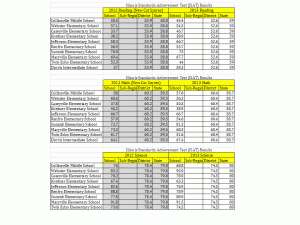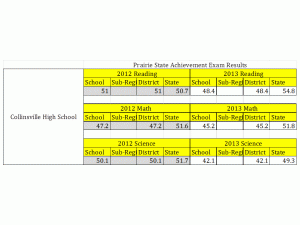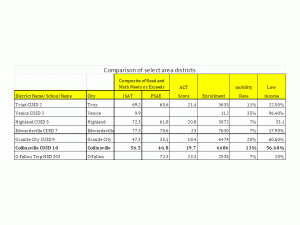The Illinois State Board of Education warned last month that school districts across the state would have fewer students meeting state standards on the 2013 Illinois Standards Achievement Tests. According to the results of school report cards released Thursday, Collinsville’s decline was in line with state averages.
Statewide, 59 percent of elementary school students who took the ISAT met or exceeded state standards in reading and math, compared with 83 percent in 2012. Collinsville Unit 10 fell from 80 to 56.5 percent.

Unit 10 ISAT test results. Reading and math 2012 results are adjusted to show results against 2013 standards. Science standards did not change in 2013, therefore, results for both years are actual. Click to enlarge
The reason for the decline is the new standards adopted by Illinois in preparation for the statewide rollout of the Common Core, a multi-state initiative that established new grade-specific guidelines and content to help students prepare for college and careers. The ISAT performance scores for reading and math were changed for 2013 to be brought into alignment with Common Core standards. Science standards have yet to change.
When past scores are adjusted for the new standard, overall student performance in the state has improved, an ISBE statement indicated.
The ISAT test will be replaced in the 2014-2015 school year with the Partnership for Assessment of Readiness for College and Careers (PARCC) assessments. PARCC is one of two standardized tests acceptable under Common Core.
The school report cards also include results of the Prairie State Achievement Exam, taken by high school juniors. Standards on this exam were unchanged.
When compared to 2012 results adjusted to reflect the 2013 standards, elementary school students in the Unit 10 district performed worse on science and reading in 2013 than in 2012. The number of Unit 10 elementary school students meeting or exceeding state standards for science decreased from 78.4 to 74.5 percent. Reading scores fell from 53.9 to 52.6 percent. The math scores increased from 60.2 to 60.4.
District scores for math topped the state average, but reading and science scores fell short. Maryville and Summit elementary schools outperformed the state average in all three categories.
Despite the statewide focus on the standardized test results, Superintendent Robert Green said the school district is more concerned with helping students succeed on a daily basis. “We focus more on how the student is doing every day, not just a test given by the state once per year,” Green said.
Collinsville has been on academic watch from the state for the past three years, but the status for 2013 was “advance.” Jefferson, Summit and Maryville elementary schools are not on academic watch status, all other district schools are on the list.
The district is taking many steps to help students succeed, Green said. The curriculum ties into the areas the students will be tested on, frequent assessments are given to the students and immediate adjustments are made to teaching methods and curriculum to provide focus where it is needed.
There are non-academic areas of focus also, for things that play a role in how well a child learns. Teachers and administrators focus on attendance and the children’s well-being. “If the kids are hungry, they will be focused on other things and not ready to learn,” Green said.
With a low-income student rate of nearly 57 percent, Collinsville faces academic challenges that some neighboring districts do not. Green said the key to helping low income students succeed is philosophy.
“First you understand that income has a lot to do with how these kids perform on tests,” Green said. “It doesn’t mean they can’t succeed, it means you need to find different ways to reach these kids and make sure they succeed.”
Statewide ISAT results show a striking difference in test success for low-income versus non-low-income students. Only 44 percent of low-income students, for example, met or exceeded the state average in reading on the 2013 ISAT test, compared with 76 percent of non-low income students.
The rate of low-income students statewide has risen steadily in recent years and now stands at 49.9 percent. Some neighboring districts that have outperformed Collinsville on standardized tests are well below the state rate of low-income students. Edwardsville has 17.9 percent, O’Fallon 20 and Triad 22.5 percent.
Regardless of income level, research has consistently shown that parental involvement is positively associated with individual student’s academic success, it is this link that Green wants to stress.
“I’d encourage every parent to go to their children’s school and stay in touch with their teachers,” Green said. “The number of parents at school drops as the kids get older, but even high school and junior high school students need this attention. The parents should hold our feet to the fire and we’d like to hold their feet to the fire.”





